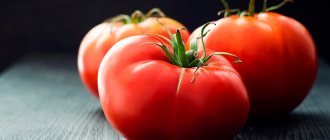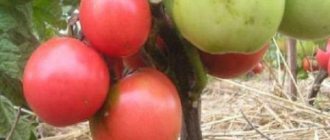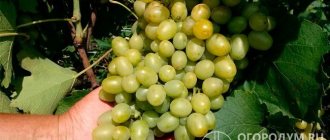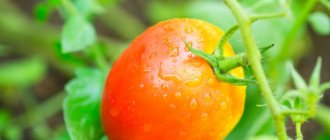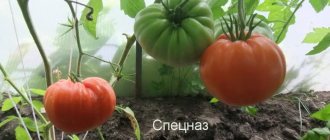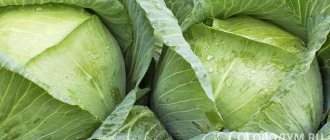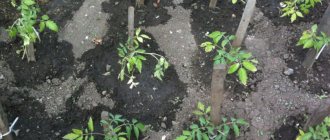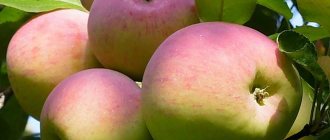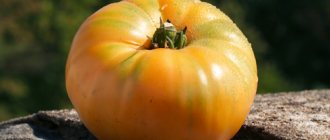Description of tomatoes Lorraine beauty
Tomatoes are of indeterminate type, with a height of 1.5 to 2 meters. The average late ripening period is 110-120 days. It is grown both in greenhouses and open ground. Self-pollinating. Productivity is low - no more than 3-4 kg per bush. Under unfavorable weather conditions, you can generally get 2-3 tomatoes.
The characteristics of resistance to viral and fungal diseases are as follows: resistant to Fusarium wilt, gray leaf spot, tobacco mosaic, Alternaria stem cancer, verticillium, cladosporiosis, nematode. Not resistant to root and white rot.
The bush is not standard - the stems are thin in constitution, large, slightly corrugated leaves. You can also add to the description of the variety that due to its specificity, it is not grown in agriculture on an industrial scale. This is a tomato for amateur gardeners and collectors of unusual plants.
Fruit
The Lorraine beauty tomato is an elegant large, ribbed, rounded fruit, flattened at the top. Outwardly they look like a closed flower with wide petals. The color of ripe tomatoes is bright scarlet. Weight is 200-350 grams, with proper agricultural technology it can reach half a kilogram.
The inside is multi-chambered, hollow, almost without seeds. The taste is sweetish with sourness. Suitable only for fresh consumption - slicing or stuffing looks impressive on the table. Dense, resistant to cracking. They are stored for a long time. They ripen well when picked brown.
Application
The harvest of this variety is suitable for fresh consumption - the vegetables are used to decorate various dishes, and delicious salads and assorted vegetables are prepared from them. Tomatoes are suitable for stuffing, but are not used in canning.
Advantages and disadvantages
The main advantages of the Lorraine Beauty variety:
- very impressive appearance of the fruit;
- pleasant sweetish taste;
- It is convenient to tie up bushes that are not too tall;
- good yield;
- resistance to viral diseases.
The yield indicators of different varieties can be found in the table:
| Variety name | Productivity |
| Lorraine Beauty | 5-7 kg per bush |
| Bobcat | 4-6 kg per bush |
| Apples in the snow | 2.5 kg per bush |
| Russian size | 7-8 kg per square meter |
| Yablonka Russia | 3-5 kg per bush |
| King of Kings | 5 kg per bush |
| Kate | 15 kg per square meter |
| Long Keeper | 4-6 kg per bush |
| Raspberry ringing | 18 kg per square meter |
| Grandma's gift | 6 kg per square meter |
| Crystal | 9.5-12 kg per square meter |
Among the shortcomings are noted:
- insufficient juiciness, “hollowness”;
- in open ground in cool weather the yield is significantly reduced;
- at insufficient temperatures, not all ovaries have time to develop into fruits.
Characteristics of the variety
Tomato Lorraine beauty is an indeterminate tall variety. The bushes are spreading and bushy. Shoots grow up to 1.7-2 m. The foliage is moderate. The bushes bear 8-12 fruits, a total of 5-6 fruiting clusters with 2-3 tomatoes on each.
Characteristics and description of tomatoes:
- average weight 400-500 g;
- the shape is round and slightly flattened;
- pronounced ribbing, the sides are corrugated like an accordion;
- the color is bright ruby, orange or yellow depending on the variety;
- pulp with chambers, moderately juicy;
- The taste is sweet with a delicate hint of sourness.
The spectacular cross-section with chambers resembles a flower. Tomato is used to decorate vegetable and meat dishes.
Fruiting may be delayed, and the variety is considered late.
Designed for planting:
- to open beds in the southern regions;
- in greenhouse conditions in the north and in the temperate zone.
More often used for personal gardens and garden plots, less often on an industrial scale.
Tomatoes are a decoration for the festive table and are indispensable for buffets and celebrations.
Productivity
The characteristics of the variety include average yield: about 10-12 tomatoes (3-4 kg per bush) can be harvested from one plant. In wet and rainy summer conditions, the indicators are very low - 3-4 tomatoes per plant.
Advantages and disadvantages
Feedback from gardeners about the experience of growing and the taste of Lorraine Beauty tomatoes allows us to add some advantages and disadvantages to the description of the variety. Characteristic positive qualities are called:
- original, decorative appearance of the fruit;
- good, moderately sweet taste;
- resistance to many diseases;
- preservation of commercial qualities during long-term storage;
- good yield indicators.
But gardeners also note the disadvantages of this tomato:
- hollowness and dryness of fruits;
- unsuitable for further processing and preservation;
- great heat tolerance for growing in our climate.
Advantages and disadvantages
The Lorraine beauty red tomato, like other varieties of the variety, is not particularly popular among Russian gardeners. Therefore, it is important to know the advantages and disadvantages of the species.
Those involved in culture note the following advantages:
- exotic fruit shape;
- long-term storage and possibility of transportation;
- do not crack when ripe;
- do not lose their taste and beneficial properties when ripening;
- pleasant taste;
- having good immunity.
The disadvantages are:
- dryish taste and lack of pulp in the fruits;
- restriction of culinary use;
- impossibility of canning;
- obvious dependence on weather conditions.
Features of cultivation
Tomatoes of the Lorraine Beauty variety are no different in cultivation technology from most classic varieties:
- sowing seeds - obtaining seedlings.
- picking.
- transplanting.
- cultivation - watering, fertilizing, garter formation.
- harvesting.
Sowing seeds for seedlings for open ground, taking into account the climate zone, is carried out no earlier than two months before the onset of stable warm weather. After 3-4 weeks, in the phase of 2-3 true leaves, they peak. They are planted approximately 30 days after picking. If warm weather has not yet established itself, the seedlings should be “tempered” - treated with the drug “Tur” or another growth regulator to avoid overgrowth.
Useful video
Watch the video: American varieties of tomatoes
| Late ripening | Early ripening | Mid-late |
| Bobcat | Black bunch | Golden Raspberry Miracle |
| Russian size | Sweet bunch | Abakan pink |
| King of Kings | Kostroma | French grape |
| Long Keeper | Brawler | Yellow banana |
| Grandma's gift | Red bunch | Titanium |
| Podsinsky miracle | The president | Slot |
| American ribbed | Summer resident | Krasnobay |
If you find an error, please select a piece of text and press Ctrl+Enter.
Planting tomatoes Lorraine beauty
It is better to grow this variety using the seedling method - this will help achieve the highest possible productivity.
Sowing time for seedlings
The optimal time for sowing seeds for seedlings is the first ten days of March. Two months before transplanting to a garden bed in a greenhouse or open ground, the seedlings will have time to grow the root system and foliage, and also reach the required height - 25-30 cm.
Seeds
It is advisable to germinate the seeds before sowing
You can plant a yellow or red variety using purchased material from a gardening store. You can also use seeds obtained from your own harvest.
Before sowing, you need to select high-quality seeds - dip them in a saline solution of 1 tsp. salt and 1 liter of water for half an hour. Seeds that have sunk to the bottom of the container are considered good.
1 gram contains 200-250 tomato seeds. If the package with seeds indicates a weight of 0.1 g, then there are approximately 20-24 seeds in the package.
They are washed in clean water, then disinfected in a raspberry solution of potassium permanganate. After 30 minutes, remove, wash with water and spray with any growth stimulator - Epin, Zircon. This treatment is necessary to increase the percentage of seed germination after sowing.
For rapid germination, the seed is wrapped in damp gauze and placed in a warm place for a day. To avoid drying out, they need to be sprayed several times with a spray bottle.
Container and soil
You can sow in any container with a height of at least 10 cm and with drainage holes. Seedling boxes, plastic containers, disposable cups or peat pots are suitable. The last option is the most optimal - there is no need to pick the sprouts. In addition, peat pots decompose well in the soil, so tomatoes are planted in holes along with seedling containers.
Peat cups will begin to fall apart within 60-65 days of growing tomato seedlings in them. They are usually used for growing seedlings of crops that do not tolerate transplantation, such as cucumbers, zucchini, and watermelons. The period for growing seedlings of these crops and using peat cups is about 1 month. The cups can be used for tomatoes after picking - plant the picked seedlings in them.
Tomatoes like to grow in light, loose soil with neutral acidity. There are two mixture options:
- purchased substrate for growing vegetable seedlings;
- homemade soil mixture of garden soil, sand and humus mixed in equal parts.
Before placing it in a planting container, the soil is disinfected in any convenient way - calcined in the oven, spilled with a strong solution of potassium permanganate or boiling water. The container is not filled with soil to the very top - leave 2-3 cm of empty space.
Sowing technique
In order for the seedlings to germinate faster, the seeds need to be planted to a depth of no more than 1 cm. Grooves are made in the seedling boxes at a distance of 5 cm from each other. Then the seeds are sown, keeping a distance of 3-4 cm. Sprinkle the top with a thin layer of earth and irrigate with a sprayer.
When planting in peat containers or disposable plastic containers, place 1-2 seeds per container.
Care
After sowing, the seeds are watered with warm water, covered with transparent material, providing greenhouse conditions, and kept in room conditions with diffused daylight. You can place boxes with seedlings on the southeast or southwest windowsill.
Until the seedlings emerge, the seedlings are periodically ventilated to avoid mold, and also irrigated with water - every other day.
A week later, when sprouts appear, the shelter is removed and the seedlings are placed in a well-lit but cool place with a temperature of 15-17°C. Such conditions are necessary to avoid stretching of sprouts and stimulate the growth of the root system. After a week, the seedlings are returned to their original location.
Transfer rules
With proper care you can get a rich harvest
In order for the sprouts to successfully take root in a new place, they should be hardened off. A week before transplanting, the seedlings are taken out into the fresh air, increasing the time spent outside daily.
Preparing the bed
Replanting is carried out in the middle or at the end of May, when the soil warms up to a temperature of 10-12°C.
The bed is cleared of the remains of last year's vegetation, sprinkled with humus (10 kg), wood ash (3 kg) and mineral preparations - 100 g of potassium salt and superphosphate. This amount is calculated for a plot of 1 m².
Technology
This is a tall variety, so it requires a lot of space on the site - the optimal planting scheme is 50x60 cm. 4-5 bushes are planted per 1 m².
They dig holes, spill them with warm water, then lower the roots of the plants, cover them with soil without fertilizers and hill them up. Next to each bush, stakes are driven in, which will serve as further support.
After planting, the tomatoes are shaded to eliminate the risk of burning young foliage and stems. It is advisable to cover it with film at night, as the bushes may freeze.
Tomato care Lorraine beauty
The agricultural technology for growing the tomato variety Lorraine Beauty is practically no different from cultivating other varieties. Tomatoes also need timely watering, plenty of sun and heat. Also, do not forget about regular fertilizing and tillage of the soil and bushes.
Garter
The first thing you need to start caring for tomato plantings is staking the bushes. Immediately after planting the seedlings, a strong stake is installed to each bush, which by this time reaches 35 cm in height, to which a garter is attached. Considering that the plants reach a height of two meters, the stakes must be tall and strong. The garter is made with a strong thread, tying not only the stem, but also the heavy, spreading branches. The frequency of the garter is every 30 centimeters.
Formation
It is best to form Lorraine beauty bushes into one stem. This approach will make caring for massive bushes easier and will save a lot of time and effort. Plants of the variety are capable of growing a large number of stepsons, which quickly germinate, shading neighboring plantings. It happens that two or three additional shoots grow from the axils at once. Therefore, plants should be pruned frequently, without allowing the sprouts to grow too much.
You cannot cut off all the extra branches at once - this creates a high risk of plant diseases due to the fact that many wounds will be inflicted on it. It is better to limit yourself to 3-5 removed stepsons in one procedure. Removal should be carried out early in the sunny morning so that by evening all the sections have time to dry.
In addition to the stepsons, you also need to remove all the lower leaves that interfere with normal ventilation. Leaves that shade fruits or other plants are also removed.
Watering
As already mentioned, Lorraine Beauty tomatoes do not tolerate cold. Therefore, you need to water the bushes only with warm water. Cold tap water will instantly cause plant stress: they will stop growing and begin to bear fruit poorly.
Fact: the optimal soil moisture for proper plant growth is 85-90%.
It is worth watering tomatoes rarely, but abundantly. In a greenhouse, it is enough to wet the soil once every 3-4 days. This is quite enough, since water evaporates slowly in the greenhouse. In hot weather, the amount of watering can be increased, but then the ventilation in the greenhouse should be increased to lower the air temperature and slightly reduce air humidity.
To get a good harvest, you need to use high-quality seeds. The most productive varieties are possible. Large selection of varieties for every taste.
Up to three liters of water should be poured under each tall bush at a time. It is necessary to pour water only at the root, trying not to touch the leaves and stem. The drier the leaves are, the less harmful bacteria will form on them, leading to fungal diseases.
After watering, the ground under the bushes can be covered with a layer of sawdust or grass - this will reduce the intensity of moisture evaporation.
Top dressing
To get a good harvest, tall tomatoes need to be frequently fed with micro and macroelements. The most important ones are nitrogen, phosphorus and potassium. With a lack of nitrogen, plants do not grow vegetative mass well. Leaves and stems become dull, leaves turn yellow. Phosphorus deficiency weakens the immune system of tomatoes. The presence of potassium affects the taste of tomatoes. If there is little potassium, then the tomatoes will be unsweetened and dry. In addition, for full development, tomatoes need magnesium and zinc, which regulate photosynthesis; sulfur, iron and manganese, responsible for the density and structure of leaves.
Care requirements
The Lorraine beauty tomato variety will give a good harvest, provided all the rules of care and maintenance are followed.
- Watering. The first moistening is carried out a week after transplanting the tomatoes into the garden bed. 1 liter of water is poured under each bush. The following procedure is carried out only after the top layer of soil has dried. The bushes experience the greatest need for moisture during the phase of budding and fruit filling, so the frequency of watering is increased to 2 times a week.
- After watering, the soil is loosened, the rows are weeded and weeds are removed. To eliminate the risk of the roots drying out, the bushes are mulched with garden soil a day after moistening.
- Tomato is responsive to organic and mineral fertilizers. The first feeding is carried out 7-10 days after transplanting the seedlings - add a solution of nitrophoska or urea - 1 tbsp. l. on a bucket of water. 200 ml of solution is poured under each bush. At the budding stage, tomatoes are spilled with liquid mineral fertilizer - 15 g of superphosphate and potassium salt per 10 liters of water. Consumption - 0.5 l per bush. The same composition is used to water the plants during the fruit-filling phase. Additionally, foliar nutrition of the bushes is carried out - irrigated with a solution of boric acid (0.2 g per liter of hot water 60°C). Plants can also be sprayed with iodine solution, which increases immunity against diseases and improves the quality of flowering and fruiting: 5 drops diluted with 3 liters of water. Foliar nutrition is carried out before flowering and a week after it.
- Forming a bush into two stems. The essence of the procedure is to isolate the central stem and the first stepson, which is formed under the first flower brush. All other stepsons 5-7 cm long must be removed. To avoid injury to the main stem, stepchildren must be removed with sterile scissors or a blade. The cut areas should be powdered with charcoal to avoid infection.
- As the main stem grows, it must be tied regularly to avoid the risk of breaking off under the weight of the fruit.
Diseases and pests
The tomato variety Lorraine Beauty is quite resistant to viruses (mosaic, fusarium wilt).
However, bushes can be affected by gray, white or root rot. Preliminary watering of the soil with a solution of potassium permanganate or copper sulfate, constant loosening and mulching of the rows with peat or straw helps in the fight.
Tomatoes attract pests that spoil leaves and roots: aphids, whiteflies, thrips. In open ground, plants can be attacked by slugs, cutworms and Colorado potato beetles.
For prevention, you can plant herbs next to the tomatoes, for example, leaf mustard or parsley. Spraying with an aqueous solution of ammonia helps destroy pests. Insecticides should not be used after flowering has begun.
Lorraine Beauty tomatoes are a rare and unusual variety that is worth trying to grow on your own plot. It is not too demanding on living conditions; it is important to monitor watering and temperature, as well as protect plants from pests.
One or two bushes in a greenhouse are enough to surprise your home with elegant chrysanthemum tomatoes for several months.
Sowing, diving and planting in the ground
- The yar is carried out into the moist soil into the grooves made. The top of the caterpillar is covered with film or glass. If it is necessary to organize additional lighting for faster germination, special lamps are used.
- The air temperature should be approximately 25 degrees.
- After emergence of seedlings, the shelter can be removed.
- When 2-4 leaves are formed, the seedlings should be planted in separate pots, or cups.
- Before planting in the ground, plants must be hardened off. In this case, the seedlings are taken outside every day for a week. This is necessary so that they get used to the change in habitat and conditions) to adapt to the open air.
- Ready seedlings are planted in the ground or in a greenhouse at the end of May. The distance between plants should be at least 50 cm.
- A nutrient mixture of organic fertilizers should be added to the prepared holes. A ridge is installed next to the holes, where the bushes will be tied as they grow. To obtain larger fruits, the lower branches should be plucked. Ant. start off.
3 bushes are placed per 1 m2. The distance between the holes is 50-60 cm, the depth of the holes is 30 cm.
